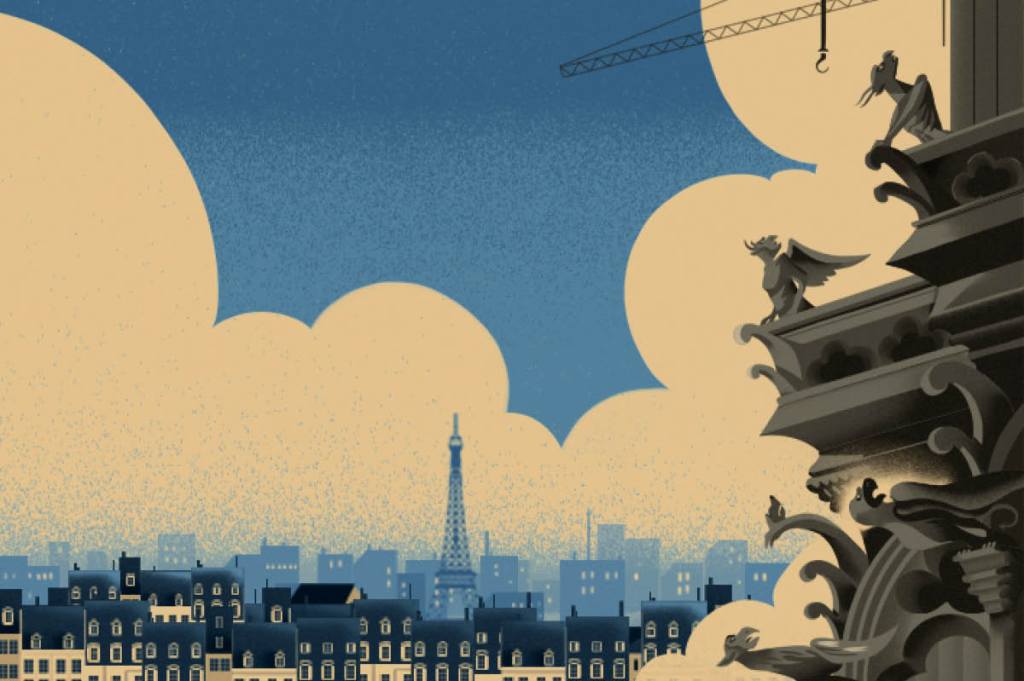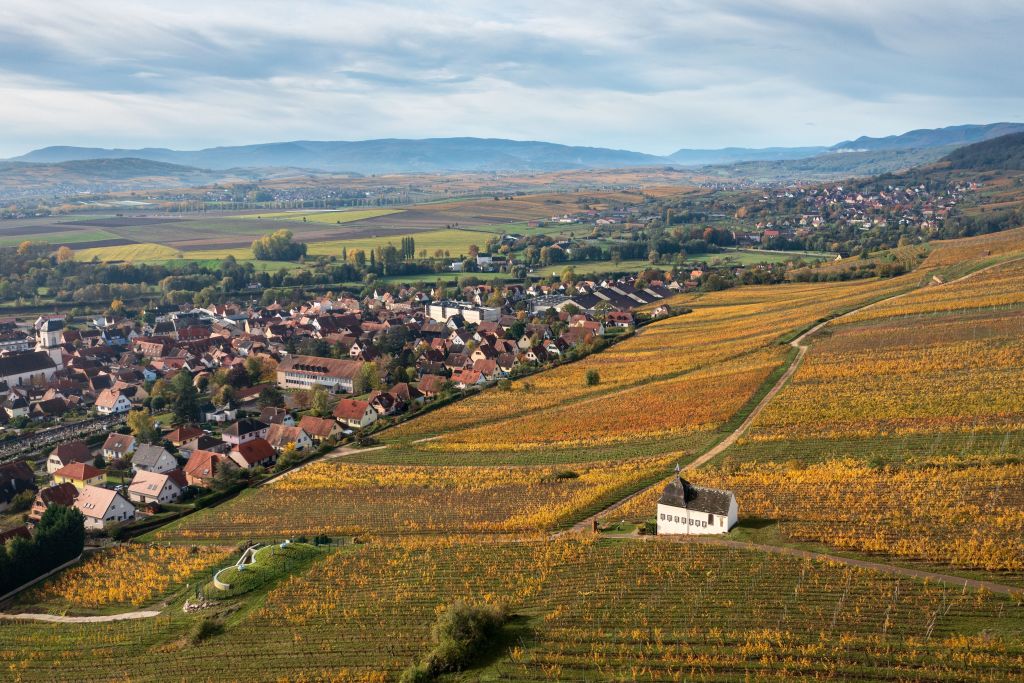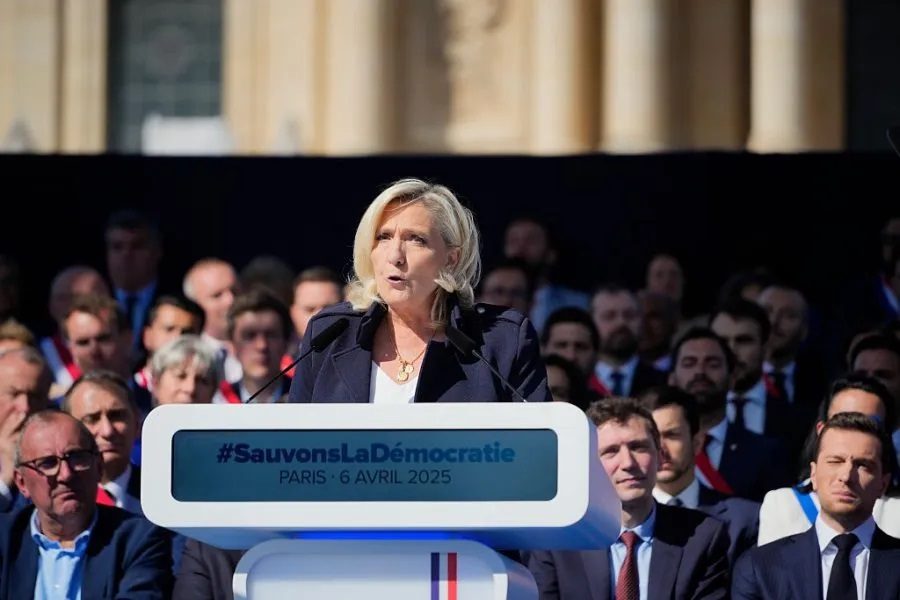Five years have passed since a major fire swept through the Cathédrale Notre-Dame de Paris on April 19, 2019, bringing down the church’s roof but sparing the rest of the building. In response, French president Emmanuel Macron immediately promised that the structure, which is owned by the state, would be rebuilt quickly, and more beautiful than before. He further promised that the cathedral would be ready to receive worshipers and visitors in time for the 2024 Paris Summer Olympics. Since his announcement, however, things have not gone entirely to plan.
Notre-Dame will not be finished in time for the Olympics; as of this writing, completion has been pushed off to December 2024. And despite the desire of Macron and others to put a visible, contemporary gloss on the building’s exterior, the cathedral roofline will look just as it did before the fire. A faithful copy of the destroyed 300-foot-tall flèche (spire), installed by architect Eugène Viollet-le-Duc in the nineteenth century to replace the vanished medieval original, was reinstalled atop the cathedral in December 2023. Many contemporary architects are disappointed with the restoration, seeing it as a lost opportunity, while others believe the good people of Paris dodged a bullet by eschewing architectural innovation, at least when it comes to one of the most important buildings in the history of world architecture.
To understand why a more conservative approach to the restoration of Notre-Dame was eventually adopted, despite Macron’s initial preference for something contemporary, I reached out to architecture and urban planning commentator Michael Diamant. Diamant is an urban sociologist and the founder of New Traditional Architecture, which helps popularize the classical tradition in architecture; he recently received a prize for his advocacy efforts on behalf of classical architecture from the Heimdal Association at Uppsala University.
“If you have a cathedral as old as Notre-Dame,” Diamant explains, “every generation adds something to it. It doesn’t look like the original thirteenth-century cathedral. There have been additions to the interior of the church, and on the exterior of the church, especially in the nineteenth century.”
Before the most recent conflagration (not the first in its history, but certainly the most significant), the cathedral was hardly in a state of pristine preservation. Like most very old structures that have remained in active use, it has been messed about with over the centuries. At various points in its history, the cathedral suffered the ravages of riots and wars, as well as attacks by anticlerical atheists, iconoclastic Protestants and misguided Catholics, as much as it suffered from the eroding effects of the elements.
Indeed, the image of Notre-Dame that we have in our minds’ eye, rising in splendid isolation on the Île de la Cité in the Seine, is of relatively recent vintage. For most of its history, the present cathedral stood amid a crowded jumble of buildings. These were all swept away by Baron Haussmann during his nineteenth century campaign to eradicate medieval Paris, so that the cathedral became a kind of stand-alone monument to France, rather than a community’s tribute to the Virgin Mary. As a result, what we see today is not the same building that was largely completed by the end of the thirteenth century, nor that left by Louis XIV after his renovations in the seventeenth century, nor that which witnessed Napoleon Bonaparte crowning himself emperor of the French in 1804.
“There’s nothing wrong with every generation making its own stamp on a building,” Diamant says, “but ever since mainstream architecture left the classical tradition, no one expects an architect today to make a good addition. They only expect an architect to make something worse. And that created the situation where President Macron had to intervene and announce that Notre-Dame was going to be restored exactly how it was before the fire, because no one trusts contemporary architects to add something of value.”
“Had the fire taken place in 1750,” argues Diamant, “they would have rebuilt it and made some contemporary changes, as architects always did.”
His view is that today, contemporary architects don’t actually know much about architecture, leading to public distrust in their ability to tackle so meaningful a project.
“The only value that they have learned, or the only attribute that they value, is that something is ‘new.’ Newness at any cost. ‘New’ is more important than ‘good.’ And so, they make things that are twisted and strange, just so they can claim that they have a new, original idea. And this is what we saw with this bankruptcy of modernism, when it came to the ideas of what to do with Notre-Dame.”
The heated debate that preceded the reconstruction of Notre-Dame began with French prime minister Édouard Philippe. A few days after the fire, Philippe announced a government competition soliciting ideas on how the destroyed roof of the cathedral should be rebuilt and, with particular reference to the collapsed 300-foot spire, expressed hope that the end result would be “suited to the techniques and challenges of our time.”
“The international competition will allow us to ask the question of whether we should even recreate the spire as it was conceived by Viollet-le-Duc,” Philippe explained. “Or, as is often the case in the evolution of heritage, whether we should endow Notre-Dame with a new spire. This is obviously a huge challenge, a historic responsibility.”
The competition led to several rather bizarre proposals that would fundamentally have changed the character of the building. These re-imaginings of the cathedral included rooftop greenhouses, space-age pinnacles and infinity pools. While some, including Macron and Philippe, favored a more innovative design, others, such as Paris mayor Anne Hidalgo, wanted the cathedral to look as it did before the fire. The French legislature eventually weighed in as well, with the Senate passing a bill to fund the restoration, but only if the roofline were restored to its pre-conflagration appearance. That language was later removed during reconciliation, with the law that passed stating, rather vaguely, that the rebuild must “preserve the historic, artistic and architectural interest of the monument.”
Retired Army general Jean-Louis Georgelin, whom Macron placed in charge of the restoration, seemed to focus on meeting the president’s reopening deadline, with little interest in aesthetic considerations of tradition versus modernism. In November 2019, during a briefing with the culture subcommittee of the National Assembly, Georgelin dismissed concerns from the cathedral’s chief architect Philippe Villeneuve over proposed stylistic innovations. “As for the chief architect,” quipped Georgelin, “I have already explained that he should shut his mouth.”
The remark caused audible gasps, led to official rebukes and provided a field day for the chattering classes; Georgelin simply shrugged them off, and managed to stay in office. In the end, however, Villeneuve and the vast majority of French citizens prevailed, with Macron accepting a plan to restore the exterior to its prior appearance, while General Georgelin had to admit defeat in the battle to get Notre-Dame ready in time for the Olympics. (Georgelin died in August 2023 while solo hiking in the Pyrenées, and will not witness the fruits of his labors.)
Yet the apparent victory of the traditional over the innovative raises the question why, if we are to stick to a classical model, returning Notre-Dame to how it looked just before the fire is more valid than choosing any other possible incarnation of the building during its long history. Couldn’t the renovation have gone even further back, say, to April 18, 1419? Diamant doesn’t think so.
“Every previous modification looked at the cathedral as a whole,” he explains. “But with contemporary architecture, the focus would then be on the addition, which wouldn’t meld, it would stick out like a sore thumb, and that’s the whole point of modernism: new, new, new, visible narcissism, me, me, me. With every previous addition, you created a new whole that supports the entire building. The building with all its refinements looks like it has always been there, it’s a natural whole. When you compare that with the suggestions that were made, they would never have been part of the whole, they would have been some sort of alien parasite.”
I observe that this is similar to what happened after World War Two with the Kaiser Wilhelm Memorial Church in Berlin, or at Coventry Cathedral in England, where instead of trying to rebuild the churches as they were, modernist architects were allowed to create modernist monsters.
“For the modernist, this result is perfect,” Diamant says. “Because then people react, when they see this disparate part of the building. For the modernist, it doesn’t matter whether what they do is good, but rather that what they do is new, so that people can see it and recognize the architect. They don’t care if people react angrily or positively, so long as they react.”
I express some surprise, however, that France chose not to take advantage of this opportunity to make at least some sort of contemporary architectural statement, given how it loves to think of itself as both ancient and avant-garde at the same time.
“The French are avant-garde,” admits Diamant, “but they’re avant-garde where it matters. They know that Notre-Dame is a national symbol, and they know the outcry there would have been globally if they had gone for something modernist. I think it was not a hard choice for them, because there would have been so much conflict, and the government would have won nothing in appeasing the architects — they could have only lost, because the proposals were so silly, and so desecrating, and it’s a cathedral that people use, not a museum, and to which they are emotionally attached.”
And of course, there’s the issue of wanting to build something cool and eye-catching for short-term gain, I observe. Almost all contemporary architecture is designed to fail within a few decades at most, not to stand for centuries or millennia. People might go look at some weird bit of modern architecture for a couple of years, but what happens when it begins to look — quelle horreur — out of fashion?
Diamant agrees. “Because the only positive thing that some people will say about a modernist building is that it is cool. And as you say, ‘cool’ is something like fashion that lasts for a very short period. An updated Notre-Dame might have looked cool, but then quickly become dated, thus destroying the building.”
I note that it seems odd, even a pity, that creating a twenty-first-century copy of a nineteenth-century interpretation of a thir- teenth-century design is the best result that could be achieved. “It’s a sign of the poverty of our times that we couldn’t make it architecturally more refined,” Diamant says. “But at least we didn’t make it worse.”
Still, not everything will be for the better once the cathedral reopens.
Thwarted in his attempt to remake the exterior of Notre-Dame in his own, matte-foundation image, President Macron is now taking full advantage of the fact that the present hierarchy of the Catholic Church has an insatiable urge to foist its love of bad taste upon the faithful. Last summer, Paris archbishop Laurent Ulrich sponsored a competition — of questionable transparency — to design new liturgical furniture for the cathedral sanctuary. The winning designs will prove a particularly painful addition to a building that has already suffered quite enough. When seen from a certain angle, the weeping Virgin in the cathedral’s Pietà, a work by the French Baroque sculptor Nicolas Coustou which emerged miraculously undamaged from the fire, will appear to be casting her eyes to Heaven over the new altar, asking, “Why did someone commission this hideous thing?”
Meanwhile, the archbishop is sponsoring a separate design competition for several new, contemporary stained-glass windows, with Macron’s backing. They are intended to replace several nineteenth-century windows designed by Viollet-le-Duc that also survived the blaze. In addition to potentially violating international cultural preservation protocols of which France is a signatory, the move has generated a new outcry among experts, including the Académie des Beaux-Arts of the Institut de France, as well as letters of protest signed by well over 100,000 French citizens to date.
Though he deplores the kind of garbage-as-art that will, at least temporarily, pollute the interior of Notre-Dame de Paris, Diamant is taking a long, activist view.
“Modernism has only been around for sixty or seventy years, and I think that ultimately it will be merely a blip in history,” Diamant opines. “And in fifty years’ time, we may be able to make meaningful additions and refinements to our churches and other buildings if we want to, while respecting their historic memory. But this demands that the entire current architectural establishment be brought down, and banished from working in architecture, and that we replace them with classical architects.
“A few of them will be extra-talented individuals, who will break the rules in a good way and create new architectural styles, so that we have both a continuation and a revival. It’s the same thing in art, it’s the same thing in poetry, it’s the same thing in classical music. Obviously, these have all been hijacked by modernism at the moment, and that’s why they are so irrelevant for the general public. The revival will begin with architecture, but it will not stop there: it will continue through other art forms as well.
“The nakedness of modernism — that’s what you see with the whole Notre-Dame affair,” says Diamant. “The cathedral wasn’t built for your personal comfort; it was built because the culture believed that there was something more important than that. Something higher, and something transcendent. And so the plans for Notre-Dame are an example of secular indifference: there’s nothing to strive for, so let’s just make everything comfortable. But if you strive for something higher, beyond your own comfort, then you can build a cathedral.”
This article was originally published in The Spectator’s April 2024 World edition.


























Leave a Reply